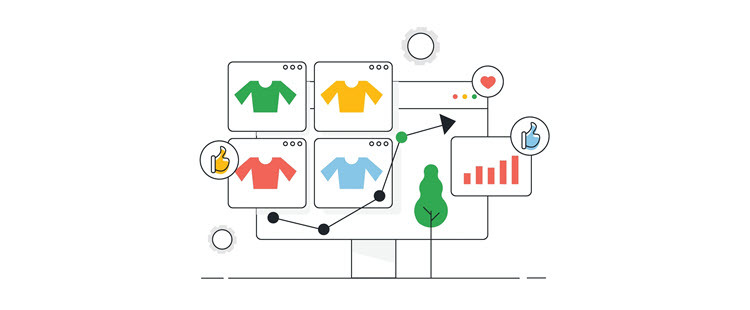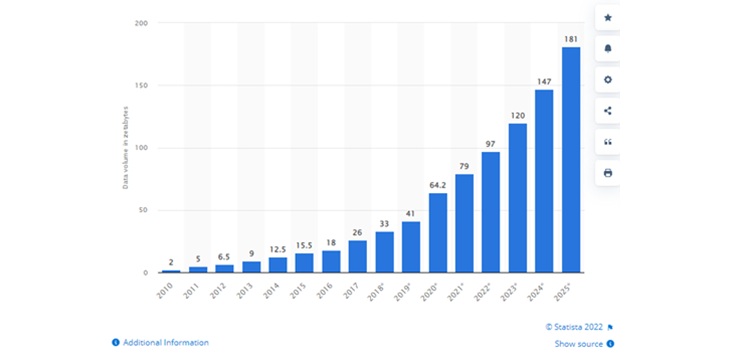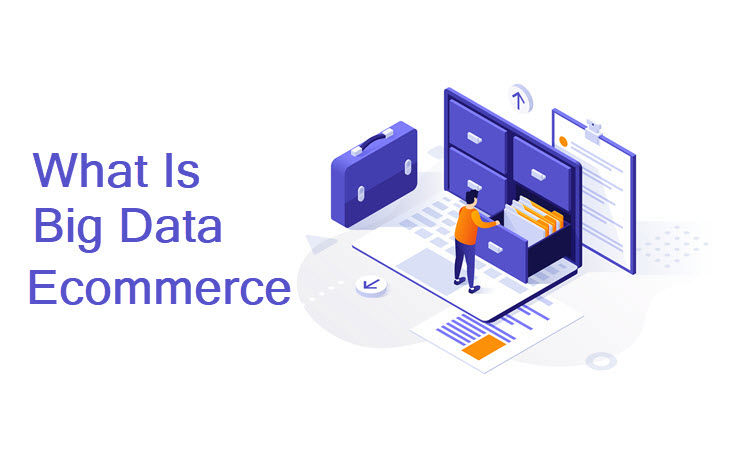With the volumes of data growing by the day, businesses are adopting modern technologies to analyze the data they collect. Big data helps ecommerce companies make better decisions, improve their ROI, develop better products and gain a competitive advantage. It also facilitates customer behavior analysis and helps ecommerce stores discover actionable insights to grow their businesses.
While it is evident that big data for ecommerce has many benefits, it also presents a few challenges businesses need to overcome to improve their chances of success.
This article examines what big data ecommerce is and how you can implement it into your business to improve your operations.
What is Big Data Ecommerce?

Big data ecommerce is the use of big data analytics to personalize the customer experience and improve user engagement, optimize operations, track performance, and forecast trends with the aim of increasing sales and driving growth.
Big data refers to extremely large sets of data that are stored and analyzed to discover trends and patterns. It is used by various industries like energy, finance, ecommerce, health, manufacturing, and even governments to mine information to improve their operations.
With the boom in online shopping, the amount of data generated has increased exponentially. Retailers harvest zettabytes of data from a variety of sources (online transactions, social media, customer interactions, etc.) to better understand their customers’ behaviors, needs, and preferences.
The data obtained by ecommerce businesses can be divided into three types:
- Structured data is easy for machines to read and fits into a data model. It includes transaction information, customer records, geolocation, numerical ratings, etc.
- Unstructured data comes in many forms and does not easily fit into a predefined data model. It includes content such as text from emails, chatbot sessions, open-ended surveys and reviews, customers service call transcripts, photos, audio, and video, social media content, etc.
- Semi-structured data is a combination of the two previous types and contain contains both structured and unstructured elements. An example of semi-structured data is a customer service call transcript which will include text (unstructured) and the name and location of the customer (structured).
All this data is stored, processed, and analyzed in big data servers to provide businesses with deep analytical insights.
Some Big Data Ecommerce Statistics
According to Statista, the amount of data generated and consumed globally is forecast to increase rapidly over the next few years. In 2020, 64.2 zettabytes of data were created and this number is projected to reach 180 zettabytes by 2025.

Image via Statista
Ecommerce generates a huge chunk of global digital data. This includes customers’ shopping habits, web browser history, abandoned carts, chatbot interactions, geolocation, and social media activity.
All this data presents a wealth of opportunities for businesses and predictions for 2023 indicate that big data will play an important role in the success of an ecommerce business.
Big Data Ecommerce Benefits
Big data presents a lot of opportunities for businesses. Companies that use it are able to make informed, data-driven business decisions.
Below, are some of the benefits of big data analytics offers.
Better Personalization
Tools like HubSpot have automated marketing efforts and have helped personalization in ecommerce evolve. Big data takes ecommerce personalization to a new level. Data collected from online stores helps retailers tailor product recommendations based on what customers buy or browse the most.
Personalization is no longer optional for businesses. In fact, customers have gotten so used to it that as many as 70% say they feel frustrated when there is none.
A company using big data can create a 360-degree customer profile, track their customer journey every step of the way, analyze their digital footprint, and determine what channels they prefer. With this information, the business creates highly personalized recommendations, using marketing strategies suited to the customer.
Dynamic Pricing
Big data analysis improves companies’ abilities to manage pricing by helping to establish the best price for the consumer while protecting all-important profit margins. Additionally, through intimate knowledge of their customers, businesses can offer personalized discounts, including special bundled offers that are likely to appeal to them.
The retail giant Amazon has leveraged the full potential of big data, which it uses to make changes to its prices once every 10 minutes. By using real-time data, monitoring pricing from competitors, and responding to demand, Amazon exemplifies dynamic pricing applied for the purpose of increasing online sales.
Improved SEO and UX
By analyzing web clickstreams and user browsing behavior, data analytics gives retailers better insights into what customers are looking for online, what they respond to and how well product descriptions match their queries. With this information, retailers can optimize their existing product pages and build new landing pages for better targeting and improved conversion rates.
Big data can also be used analyze how customers are using a website, what they find attractive, where they are likely to abandon their visit, and the obstacles they face when completing a purchase. The information can help businesses design a webstore that creates a satisfying customer experience and has a competitive edge over its rivals.
Improved Customer Fulfilment

Online retailers can use big data analytics to optimize their fulfilment process in several ways:
- Inventory management. Business can use big data to analyze historical sales data, customer behavior and market trends, helping them forecast increased demand and reduce overstocking and stockouts.
- Shipping and logistics streamlining. By analyzing delivery routes, shipping times and carrier performance, business can find the best solution for their business and improve customer experience.
- Reliable order tracking. Big data helps to track shipments by providing real-time updates on the status of orders.
- Returns management. Retailers can leverage big data analytics to learn more about the quality of their products, return rates, and customer feedback.
Secure Online Payments
The growth of online payment fraud possibilities has grown in harmony with the rise in popularity of online shopping. With vast volumes of customer data and payment information collected every day, protecting this information has become essential for businesses.
Here are some of the ways big data helps to prevent fraudulent activity:
- Analysis of customer behavior and transaction history to spot suspicious patterns and anomalies.
- Real-time monitoring of transactions to enable quick identification of threats and timely response.
- Enhanced authentication and verification of users by analysis of two-factor authentication elements (e.g., biometric information, used device, location) to prevent account takeover.
- Monitoring compliance with security regulations and standards, such as PCI-DSS and GDPR, to identify vulnerabilities and mitigate risks.
Reduced Operational Costs
Another benefit of big data ecommerce is cutting operational costs. Big data analytics helps optimize almost every aspect of an ecommerce business, from customer acquisition and customer retention, to energy management and systems and equipment monitoring. Optimization of these elements leads to reduced operational expenses.
Informed Decision-Making
All the benefits listed above come together to help ecommerce companies make better business decisions. Big data gives decision-makers a deeper understanding of the business’s customers, competitors, and market trends.
These insights help companies build stronger customer relationships, optimize spending by reducing waste and inefficiencies, create effective marketing strategies, and identify prudent investment avenues. Through big data analytics companies achieve their business goals, mitigate risks, and build resilience.
Features of Big Data
Big data is described as possessing a set of features that are known as the “Vs” of big data. These features of big data are:
- Volume. There is no upper limit to the size of big data. It commonly comprises terabytes or more.
- Velocity. Big data is frequently collected in real-time and is updated at a fast rate.
- Veracity. For big data to provide valuable insights it must be true and come from trustworthy sources.
- Variety. Big data includes large sets of different types of data from a vast array of sources.
- Value. Large amounts of data remain meaningless if they do not provide information that can be used effectively.
It is precisely these attributes that present the greatest challenges for those who would leverage big data’s potential.
Big Data Ecommerce Challenges

Any business wishing to utilize the full potential that big data will necessarily face a set of challenges that stem from the inherent nature of big data. Let us take a deeper look at the problems big data presents to ecommerce businesses.
Technical Challenges
These problems stem from the volume and variety of data sets and the speed at which they are collected. To store large amounts of data, companies must carefully assess the goals they want to achieve and the size of IT investments necessary that are not just limited to the cost of the database server.
Once stored in a database, the data needs to be processed and ecommerce businesses must select the right tools and technologies to manage the data and gain actionable insights. Wrong choices in this area can have far-reaching negative consequences that include out-of-control IT spending, scalability issues, and security breaches.
Quality Issues
Big data usually includes large data sets that are only valuable if their quality and accuracy is assured. Inconsistencies with data quality can be due to the following:
- Incomplete data due to missing elements.
- Technical issues and human error.
- Lack of consistent use of data formats.
- Poor processing of unstructured data which requires special analysis tools.
- Data breaches, fraudulent activity, and manipulation.
Data Privacy Concerns
Regulators are imposing more requirements regarding the privacy of user data. Both the Payment Card Industry Data Security Standards (PCI-DSS) and General Data Protection Regulation (GDPR) enforce businesses to seek consent from users regarding their private information. These regulations also demand that private information is protected from unauthorized access and theft.
Security Management Challenges
Big data is vulnerable to both physical threats and cyberattacks. Physical threats include natural disasters and unauthorized access by malicious actors. On the other hand, the online environment also harbors a host of threats. These come in various forms and range from ransomware attacks, where hackers essentially take hold of business critical data and hold it ransom, to SQL injections, which directly target a database and can seriously corrupt and even delete data.
All these security issues require considerable financial and technical investment. However, ignoring the seriousness of these threats can lead to loss of business-critical data, disrupted business continuity, and reputation loss.
Skilled Workers Shortage
Managing data and the architecture that supports it requires workers with a high skill set. These kinds of people are in high demand and can be difficult to find.
How to Successfully Integrate Big Data into Your Ecommerce Business
Integrating big data in ecommerce can help online merchants to make data-driven decisions that improve the bottom line and achieve business goals. Businesses wanting to leverage the power of big data should follow these recommendations:
Step 1: Define Goals
Before you start aggregating data, you have to be clear on what your business goals are and what you expect to achieve with the data analysis. This way you can ensure that you do not end up with an overabundance of unusable information.
Step 2: Identify Sources of Data
Discover where you will collect data and what type of data it will be. Knowing beforehand what type of data will affect how you will collect it and which technology you will be using.
Step 3: Determine Your Tech Stack and Infrastructure
Once you understand what type of data you will be collecting, determine which tech stack and infrastructure you are going to use. There are a number of out-of-the box solutions for big data analytics specifically in ecommerce. Alternative options include running your own infrastructure for big data processing.
Step 4: Ensure Data Security
Protect your data to ensure customer information does not get into the wrong hands. Implement tight security measures to ensure your business is not compromised by cyber-attacks.
Step 5: Start Collecting Data

The more high-quality data you have about your customers the better. This will make your ecommerce marketing strategy more competitive and suited to the needs of your customers.
Step 6: Organize Your Data
If the data you collect is organized properly, it becomes easy to retrieve and analyze. This reduces the time it takes to find and sort the data, thus enhancing your business operations and speed of analytics.
Step 7: Ensure Data Quality
The success of big data ecommerce depends more on the quality than the quantity of the data collected. Instead of collecting as much data as possible, ensure that the information you get is of accurate and useful. Make sure you periodically audit the gathered data to identify errors and ensure the validity of the information.
Step 8: Analyze the Data
For humans, the final decision-makers, to make use of big data, it needs to be translated into a language easily understood. Enable effective data visualization so that it is easy to identify patterns and trends and draw conclusions for best business outcomes.
Step 9: Improve Access to the Data
Eliminate all barriers between the data you have and the people who need to use it. This allows you to improve the speed with which the data is analyzed and helps you come with data-driven insights quickly.
Conclusion
Big data has taken the ecommerce industry by storm. It not only helps businesses increase revenue, but customers also benefit from personalized shopping experiences.
Merchants not yet using big data analytics to optimize their business should consider adopting it to keep up with the competition. Use the tips above to take advantage of the growth opportunities big data offers.
